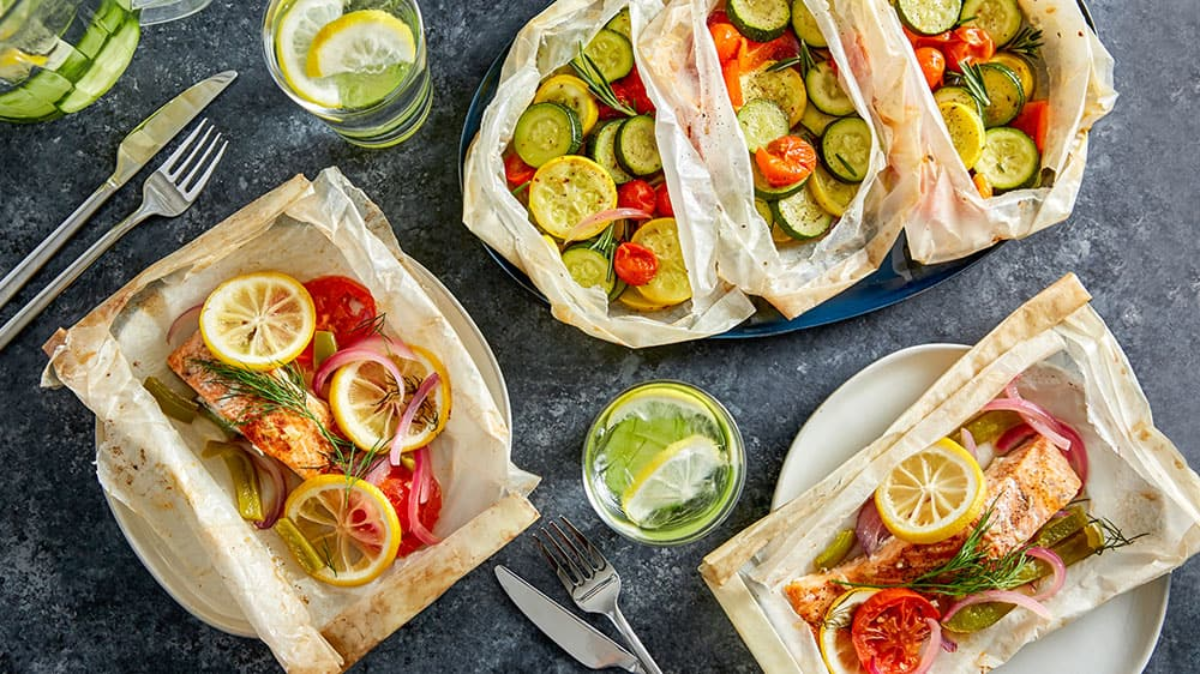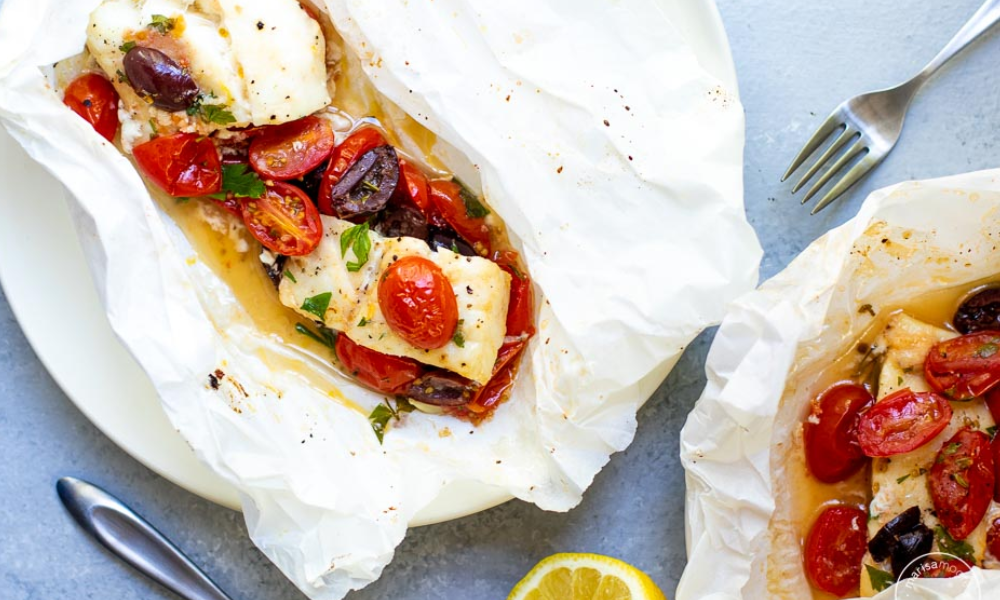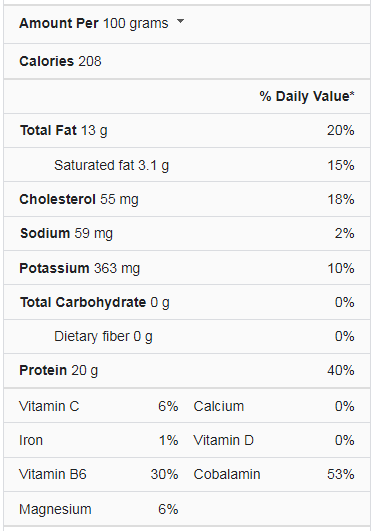Fish en papillote, or fish steamed in parchment paper, is a tried-and-true method for serving soft fish. The fish is cooked in its juices and the fluids of whatever else you add as it is wrapped in parchment, producing a flaky fillet that is bursting with flavor. The procedure is easy, quick, and requires almost no cleanup! A healthy way to cook fish to delicate perfection is on parchment paper.
Steaming is a great low-fat cooking technique because it requires little to no added fat. Your fish and veggies are placed in the package with a small amount of liquid, which turns into steam in the hot oven and cooks everything rapidly. You can use broth, lemon juice, butter, wine, or any other flavorful beverage! Fresh herbs and extra spices can enhance the enticing flavors of your seafood.
Fish Nutrition Facts
What is Parchment Paper?
Silicone covers parchment paper, making it nonstick, lubricant-proof, and heat-resistant. It is also known as bakery paper or baking paper. White parchment is chemically processed to eliminate the paper’s natural color, whereas brown parchment is not. You may use parchment in the oven and microwave. Although you should always check the manufacturer’s advice, most brands are oven-safe up to 420 F.
Like aluminum foil, parchment paper is frequently provided in rolls, so you may cut off the exact amount you need for a given operation. Pre-cut parchment sheets are practical and come in different sizes; the most popular size fits an ordinary baking sheet. In addition, parchment with stamped rings can be used to line air fryers and bamboo steamers and assist with space cookies and macarons.
How to Cook Fish in Parchment Paper?
With summer squash, zucchini, and olives in a buttery white wine sauce, this fish in parchment is a healthy way to cook fish to delicate perfection. Even though you may multiply the ingredients to make more, it only yields one serving.
Ingredients
- One scallion is trimmed and thinly sliced.
- One summer squash trimmed and thinly sliced (about 1/4-inch or 6-mm thick)
- One green zucchini trimmed and thinly sliced (about 1/4-inch or 6-mm thick)
- 2 ounces black olives pitted and halved
- One small bunch of basil
- Salt and freshly ground black pepper
- One tablespoon of olive oil
- Three fillets of lemon sole (or other mild, delicate white fish, such as flounder), each skinned and cut into four portions
- Four tablespoons (2 oz) butter cold, cut into small pieces
- 3 to 4 tablespoons white wine
Directions
-
Preheat the oven to 350ºF (176ºC). Cut four pieces of parchment paper or aluminum foil, each measuring close to a 12-inch-by-12-inch square.
-
In a large bowl, combine the scallion, summer squash, green zucchini, black olives, and basil. Season with salt and pepper, drizzle with the oil and mix well.
-
Divide the vegetables among the pieces of parchment paper or foil, placing a small but heaping mound in the center of each square.
-
Place three sole fillets on each mound, and fold each portion in half to prevent it from overcooking. Season the sole with salt and pepper. Divide the butter evenly among the mounds and dribble a scant tablespoon of wine over each.
-
Fold the paper or foil over the sole to create sealed parcels (fold on opposite sides simultaneously, then repeat with the two remaining sides. Seal the parcels tightly by folding over the edges and crimping them together. Be sure to leave a little space inside the parcels for the steam.
-
Place the parcels on a rimmed baking sheet and place in the hot oven until the sole is cooked through, 10 to 14 minutes. (If using foil, it may take a few minutes longer.)
-
Immediately serve the parcels at once, placing them on plates and offering each guest a sharp knife to slit the parcels-and an equally sharp warning about not holding their faces too near the steam-puffed parcels as they set about making said slit.
What is the Different Between Parchment and Wax Paper?
The key to baking is to use the perfect number of ingredients and to cook them for the proper period. So, when baking, accuracy in terms of quantity and time is crucial. Along with the basic ingredients, baking calls for specific supplies and equipment. These include parchment paper, wax paper, oven gloves, and baking utensils. If you are new to baking and trying your hand at it, you must have a fundamental understanding of them. Here is a crucial lesson for those of you who are inexperienced bakers: the distinction between wax paper and parchment paper:
Parchment Paper
Papers with a cellulose base called parchment are used for baking. Due to their acid treatment, these papers provide a nonstick surface when baking. Typically, sheets of paper pulp are put through a bath of sulfuric acid or zinc chloride to create parchment paper. The purpose of this procedure is to gelatinize the paper. It creates a cross-linked sulfurized material with great density, stability, and heat resistance. This gives the paper good nonstick and releasing qualities.
Wax Paper
Paper that has had wax embedded or coated on one or both sides is known as wax paper, paraffin paper, or waxed paper. Wax paper shouldn’t be used in the oven, though. This is mainly because wax paper can only withstand so much heat before melting.
How are they Different?
- The main difference between wax paper and parchment paper is their respective coatings. Parchment paper is coated with silicone to give it a nonstick, heat-resistant surface, and wax paper is coated with soybean or paraffin wax.
- The wax paper is made with a wax coating, so it cannot handle heat well. Anything above room temperature will cause the wax to start melting, and anything too high will risk catching the paper underneath the wax on fire. On the other hand, parchment paper is covered in silicone and can thus handle heat well. Even at high temperatures (over 450°F), the paper may brown, but it will not burn.
- Wax paper cannot be recycled due to the coating, nor can it be composted. On the other hand, parchment paper can’t be recycled if it’s stained with food but can still go in the compost bin.
What are the Uses of Parchment Paper?
There are endless uses for parchment paper once you have a roll in your kitchen. Some of our favorites are as follows:
Line Baking Sheets and Cake Pans
Baking pans are lined with parchment paper most frequently. Baking sheets can be used without needing to be greased, and cleanup is simpler when they are covered in parchment paper. The parchment paper can be used repeatedly for baking numerous batches of cookies.
Cut the parchment to fit the pan if you’re baking bread or cakes. The parchment stays in place by being greased and pressed onto the pan. Leave an inch overhang for square or rectangular pans, and the baked items will be much simpler to remove: lift the hanging borders! For roasting veggies, parchment is also excellent for use on baking pans.
Layer Between Sticky Cookies or Candies
Placing a sheet of parchment between each layer in your container or box can prevent frosting from smearing and baked goods and candies from sticking together. Even the paper you used to line the baking pan can be repurposed for this.
Cover a Work Surface
Your work area is simple to clean if you tape a sheet of parchment. After finishing, remove the tape, roll the parchment over the mess, and discard it. When making meatballs, rolling out pastry dough, and performing other grubby activities, it’s a terrific trick.
Funnel Ingredients
Use paper to simplify tasks like sifting flour and other dry ingredients, pouring grated cheese into a pan, and filling a little shaker with handmade cinnamon sugar. Please make the necessary calculations on a sheet of parchment, then take sides and bend them into a funnel or a pouring spout. Nothing will be left to tidy up because every last piece will find its way to its proper place.
Cook En Papillote
En papillote is a cooking method that uses a pouch to cook food and seasonings. With its fragrant steam bath, a piece of fish or chicken in a sealed packet ensures a tasty and delicate entrée. While foil can be used, parchment presents food better and can be placed directly on the dinner plate.
Is Using Parchment Paper Safe?
Chefs claim that using parchment paper for baking and cooking is safe. It has been established that the silicone coating on parchment paper makes it resistant to heat, moisture, and oil.
- Since the parchment paper is heat-resistant and nonstick, bakery professionals vouch that it is safe to use in ovens. It can be utilized for baking and even gently warming food. Additionally, parchment paper can withstand heat up to 450F and is safe for use in cooking. It has been demonstrated that the silicone coating makes it resistant to moisture and oil, making it suitable for cooking.
- There are two varieties of parchment paper available locally: bleached and unbleached. The unbleached one is brown, while the bleached one is white. The bleached one may also contain hazardous dioxin, which, when cooked, could leak and turn the meal toxic, according to experts. It is advised to get an unbleached variety to eliminate any dangers.
- Experts claim that parchment paper is resistant to heat and can endure temperatures up to 450F. But if it catches fire, it can burn further than this.
- Like any other culinary tool, parchment paper is great for baking and the oven, but it must be used carefully to prevent accidents. Before using any parchment paper, it is strongly advised to read the instruction card.
Conclusion
Paper that has been carefully prepared for use in ovens is resistant to moisture and grease. It can line cake pans and baking sheets, wrap fish and other cooked en papillote items, cover countertops during dirty chores to make cleanup simple, and many more. It is quite adaptable. You can just let the ingredient fall into the paper while grating or sifting a tiny portion, then pick up the paper and pour the mixture into a dish.
The affordable papers can be used for various jobs, such as pouring ingredients, steaming seafood, and lining baking sheets and cake pans. The paper used for parchment is silicone-treated to make it nonstick, heatproof, and grease-resistant. You can get it unwashed (gray) or bleached (white) (brown). Food won’t stick to pans, and it makes cleanup easier.



